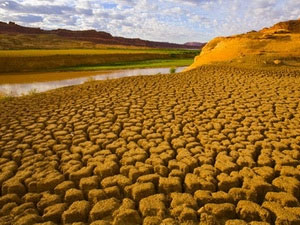WMO: La Nina's weather phenomenon is about to end
On May 23, the World Meteorological Organization (WMO) said La Nina's weather phenomenon caused heavy rain and storms in many areas and droughts in many parts of the world are about to end.
 Drought in many parts of the world. (Source: Internet)
Drought in many parts of the world. (Source: Internet)
The intensity of La Nina is relatively strong throughout the first quarter of 2011 on the oceans and very strong in the atmosphere but since February has weakened on the oceans and is now approaching to end around the end of May.
The latest WMO update highlights the formation of the El Nino phenomenon or the re-emergence of La Nina phenomenon that could not take place in mid-2011, but does not preclude these weather events from occurring in the second half. year.
The most feasible climate scenario in mid-2011 is neutral weather conditions with temperatures on the ocean, tropical rain patterns and wind in equatorial areas of the Pacific near the average measured in long time.
The current La Nina weather phenomenon starts from mid-July 2010 with the peak of January 2011. The surface temperature of the tropical area between the Pacific Ocean is 1.5 degrees C cooler than the period from September 2010 to the beginning of March 2011, indicating that La Nina is currently only at a moderate level.
However, atmospheric conditions such as changes in pressure on the surface of the ocean, wind and clouds . are considered the most powerful compared to the 20th century. Therefore, due to the influence of La Nina, extreme rain has occurs in Indonesia, the regions of North and East Australia, Southeast Asia and North South America.
Rainfall in the equatorial areas of East Africa, the Central Region of South-East Asia and Southeastern South America is only below average precipitation many years ago.
La Nina phenomenon originates from abnormal cold temperatures on the surface of the equatorial region of Central and Western Pacific. In contrast, the El Nino phenomenon originates from the unusually warm temperature of the ocean surface also in this area.
The update of La Nina and El Nino phenomena is the consensus product between WMO and the American Institute of Weather and Social Research (IRI) on the basis of data obtained from weather forecast centers and global meteorological experts.
- El Nino weather phenomenon may soon appear
- 'The phenomenon of La Nina will end globally
- La Nina weather phenomenon has reached its peak
- Rain of blood and weather phenomena of 'bad crying and laughing' in history
- The culprit caused an unusually hot and cold weather phenomenon
- The truth about the weather phenomenon inside the ice picture looks like a cake
- Unusual weather phenomena in the world
- How is the cold weather damage?
- At the end of December, there will be the first cold, damaging cold spell
- Video: The reason why snow appears during thunderstorms
- Tips to deal with the weather
- Why do hairs stand on a dry, cold day?
 Is the magnetic North Pole shift dangerous to humanity?
Is the magnetic North Pole shift dangerous to humanity? Washington legalizes the recycling of human bodies into fertilizer
Washington legalizes the recycling of human bodies into fertilizer Lightning stone - the mysterious guest
Lightning stone - the mysterious guest Stunned by the mysterious sunset, strange appearance
Stunned by the mysterious sunset, strange appearance